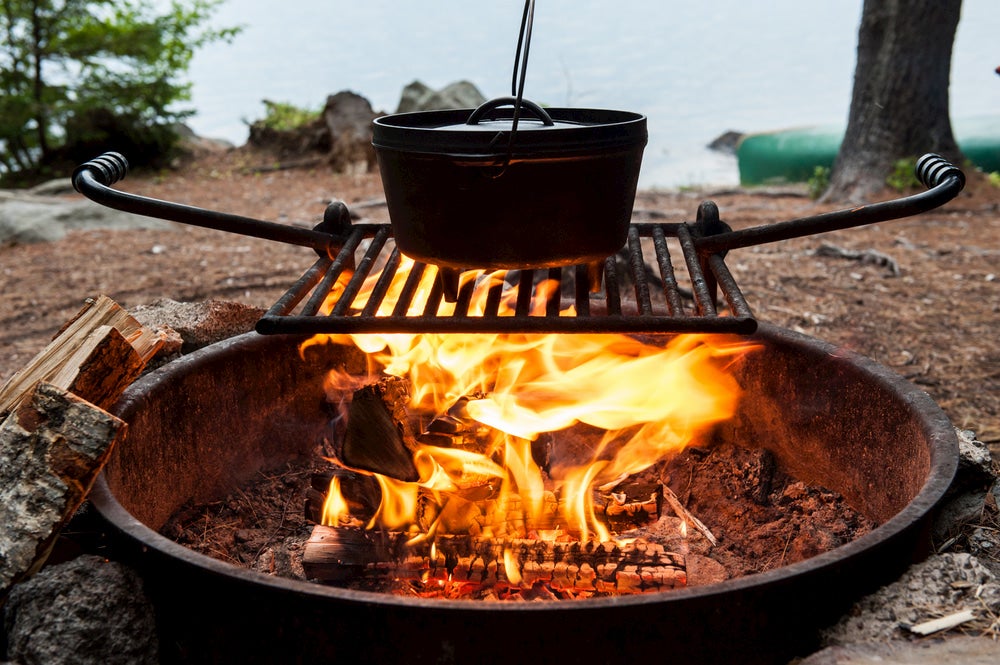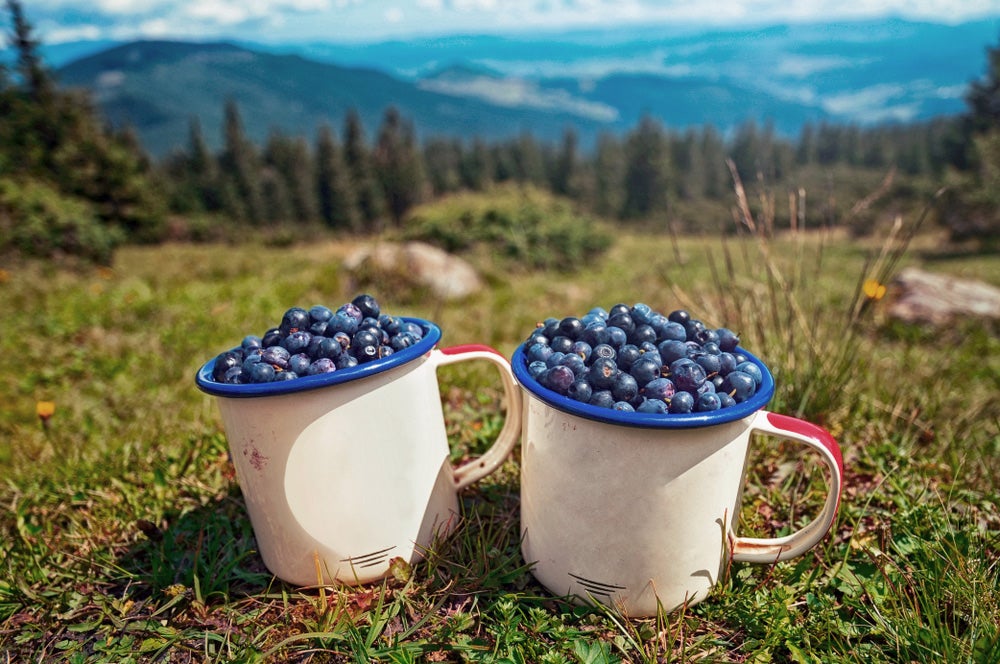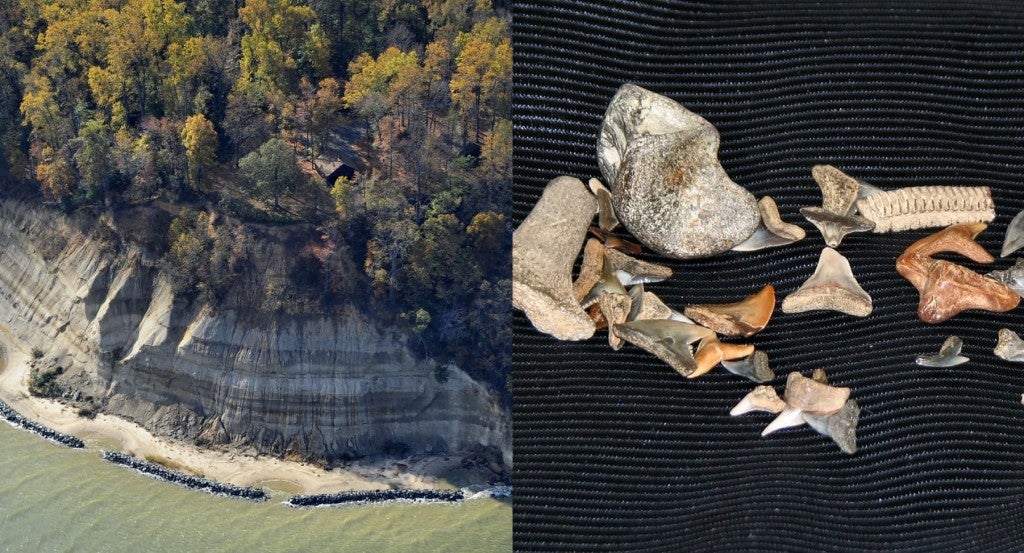A treat I cook on practically every camping trip is a cobbler. The recipe is always the same—always a cake-based cobbler (usually using blueberries, but any fruits that are in season can work) and always cooked in my Dutch oven. I love cooking this easy blueberry cobbler on a camping trip for two reasons; it’s easy to cook over a campfire (as few things are), and clean up is a cinch.
I might add a third reason to that list—it’s wildly delicious.
Easy Blueberry Cobbler Recipe to Make on Your Next Camping Trip

Baking over an open fire may seem a bit intimidating, but in my experience, it’s easier than it sounds. The hardest part is starting a fire—once you get the coals going, the rest is, well, cake. If you really want to make this even easier, use charcoal briquettes in your campfire. I find the heat easier to control with briquettes, because of their uniform size and clearer indication of heat.
For camp baking, a Dutch oven is a must. While they are heavy, the cast iron makes for a wonderful conductor of heat, baking your easy blueberry cobbler evenly and quickly. If you’ve never tried baking with a Dutch oven before, this blueberry cobbler is a great recipe for beginner camp bakers.
Easy Campfire Blueberry Cobbler Ingredients:
- 1 box yellow or vanilla cake mix
- ¾ carbonated water (or lemon-lime soda)
- 4 cups prepared blueberry pie filling
- 2 tbsp butter, cut into cubes
- 1 tsp vegetable oil
- 25 charcoal briquettes or coals from the campfire
- Seasoned cast iron Dutch oven
- Stainless steel tongs
- Paper towel
- Leather glove or Dutch oven lid lifter
Note: You can use charcoal briquettes or hardwood coals from your campfire for this recipe–both work well. If this is your first time baking in a Dutch oven, stick with the briquettes. They heat up faster and it’s easier to tell when they are ready (they will be white and glowing red on the inside).
Preheat The Dutch Oven

Start a fire or light charcoal briquettes in a charcoal chimney. When they are ready, spread about six of the briquettes into a little pile. The Dutch oven will sit on the coals. If your Dutch oven doesn’t have legs, use rocks or larger pieces of firewood to elevate it a couple of inches above the coals. Place the lid onto the pot and place eight of the briquettes on to the lid. You will need to add the rest of the coals as needed when those on and under the Dutch oven burn up. Allow it to heat for ten minutes.
Add The Ingredients

While the Dutch oven is heating up, mix the carbonated water and cake mix in a separate bowl. Remove the oven from the heat, then remove the lid with a pair of tongs (careful, it will be hot). Add the vegetable oil and spread it around the inside of the Dutch oven using a paper towel at the end of the tongs. Pour in the cake batter first, then add the blueberry filling. Spread the pieces of butter evenly over the top and replace the lid.
Cooking
Check the conditions of the coals that were beneath the Dutch oven. They should still be glowing with heat. Place the Dutch oven back onto the coals. Spread eight briquettes evenly onto the lid. With leather gloves on or using a Dutch oven lifter, rotate the pot a quarter turn clockwise and rotate the lid a quarter turn counter-clockwise every ten minutes. Since you are cooking in a less controlled environment, these rotations help to mitigate the effects of hot spots, promoting even cooking. As the coals burn down, gradually add coals from your reserve piles as needed.
Checking/Finishing

Cooking time will vary depending on how hot your coals are. Take a peek after a half hour, then about every 10-15 minutes after. If the cobbler seems to be cooking too hot (the edges cooking much faster than the middle) adjust the baking temperature by removing some of the coals off the lid and underneath the oven.
The cobbler is done when the cake is a golden brown and the filling is bubbling. Serve the cobbler warm with some ice cream or whipped cream!
Cleanup
Cleaning a cast iron Dutch oven is easy. Scrape the remnants as thoroughly as you can, then put it back on the fire. Soap is the enemy of cast iron, as it will ruin the surface. Simply heat it until all food remnants have burned to ash. Let it cool, wipe out the ash, and coat it inside and out with fat (vegetable shortening works fine).
The Dyrt is the only camping app with all of the public and private campgrounds, RV parks, and free camping locations in the United States. Download now for iOS and Android.Popular Articles:
Articles on The Dyrt Magazine may contain links to affiliate websites. The Dyrt receives an affiliate commission for any purchases made by using such links at no additional cost to you the consumer.



